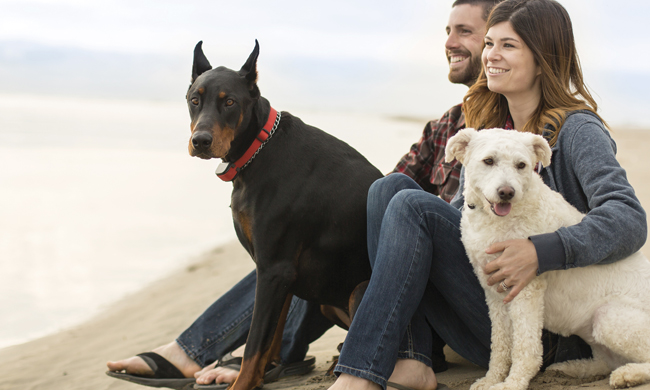10 Steps to Prep Your Pet for Travel
May 15, 2017 04:34AM ● By Family Features

When summer comes around, a common favorite tradition is jumping in the car and hitting the open road for a vacation, whether it’s a weekend getaway or a longer excursion. For pet parents, that exhilarating idea isn’t always so simple.
Instead of being forced to leave your furry friend behind, follow these tips and suggestions to bring your four-legged companion along for the ride.
Get checked out. Before loading up the car, consider a check-up with a veterinarian to ensure that your pet is physically capable of handling a road trip. Long hours in the car can be taxing on older pets that may not be used to the stress of travel.
Prepare your pet. Once you’ve made sure your pet is ready to hit the road, start out with short drives to make sure he or she is comfortable in the car. Take a trip around the neighborhood or about town to check his or her reaction and attitude.
Plan accordingly. Since not all hotels and accommodations are pet-friendly, be sure to double-check that your reservations allow furry guests. Additionally, make sure that all of your planned activities and adventures can safely involve your pet.
Pack necessary supplies. While you’ll likely be concerned with packing the right clothes, shoes and accessories, your four-legged companion has needs as well. Make sure to bring along proper food, water and respective bowls; toys for down time; treats for good behavior and any other necessities to help your pet feel at home.
Travel safely. Even pets that have spent ample time traveling in the past can feel more comfortable in the car while inside a cozy carrier. It can be a good idea to bring along a breathable carrier with plenty of space to help serve as a calming presence in case travel time starts to take its toll.
Take proper ID. It’s important to always have your pet’s ID on its collar, but it can be even more important while out of town when your pet is in an unfamiliar area.
Plan for play. You’re sure to have plenty of activities planned during vacation, but keep in mind that your pet will need some time to stretch his or her legs, too. Prior to taking off, look for parks or other pet-friendly areas on your route to incorporate some playtime.
Stay inside the vehicle. The iconic image of a pet-friendly road trip is a dog with his head out the window and the wind in his face – however, it’s not a safe way to travel. Make sure your pet is safely inside the vehicle at all times.
Make frequent stops. Even if you can “hold it” for lengthy periods, your pet will likely require more frequent bathroom breaks while on the road. Mapping out pet-accessible stops can help you keep your pet comfortable while still making good time.
Don’t leave your pet. It’s never smart to leave pets or children in locked cars, and it’s an even bigger no-no if you’re in an unfamiliar place. Your pet is likely to be on high-alert anyway due to the stress of traveling, so keep him or her by your side throughout the trip.
With these steps, you can hit the road for some summer fun without having to leave your pet behind. Find more pet care tips at eLivingToday.com.

Solving Pets’ Oral Health Needs
A shiny coat and bright eyes are signs your pet is in good health, but his or her mouth may tell another story. Especially if your pet is on a regular dosage of medication, he may experience dry mouth or other oral health issues.
In fact, one of the leading causes for dry mouth and some other oral health issues can be certain medications, which can have a negative effect on the production of healthy saliva. That lack of healthy saliva, or even a reduction in its protective quality, can cause bacteria and fungi to grow in a pet’s mouth. This can lead to dry mouth, which in turn can lead to issues like bad breath, excess plaque accumulation, periodontal disease and tooth loss.
Whether you suspect a problem or just want to take preventive measures, protecting and improving your pet’s oral health is a multi-step approach.
Schedule regular cleanings. Having your pet’s teeth cleaned by a trained veterinarian can help stop problems before they start, as a vet may be able to identify emerging issues during a cleaning before they become a more serious concern.
Provide ample drinking water. It may seem obvious that your pet needs daily water, but for a pet with dry mouth, it’s exceedingly important to provide plenty of access to fresh water. In addition, specially formulated water additives can help eliminate bacteria and reduce plaque buildup.
Deliver oral care every day. Brushing your pet’s teeth daily is a good place to start, but it isn’t always a realistic solution, and for pets on medications, brushing every day may still not be enough. Another option to help combat dry mouth is Zymox Oratene Brushless Oral Care, which can destroy germs that cause bad breath, eliminate the plaque biofilm that can lead to tartar and provide a therapeutic benefit for pets on medications. The line includes a toothpaste gel, breath freshener and drinking water additive.
Establish a routine. Maintaining a daily schedule can help your pet get used to the different ways that you manage his or her oral health. This may include adding moisture to food or using products designed to promote good oral health, such as breath freshener sprays that wash and protect teeth or brushless products that make it easy to establish a daily routine.
Find more solutions to protect your pet’s oral health at zymox.com.
Photos courtesy of Getty Images




